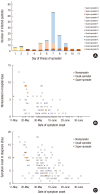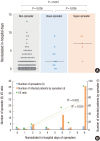Clinical and Epidemiologic Characteristics of Spreaders of Middle East Respiratory Syndrome Coronavirus during the 2015 Outbreak in Korea - PubMed (original) (raw)
. 2017 May;32(5):744-749.
doi: 10.3346/jkms.2017.32.5.744.
Kyoung Ho Song 1, Pyoeng Gyun Choe 1, Wan Beom Park 1, Ji Hwan Bang 1, Eu Suk Kim 1, Sang Won Park 1, Hong Bin Kim 1, Nam Joong Kim 1, Sung Il Cho 2 3, Jong Koo Lee 2 3, Myoung Don Oh 1 4
Affiliations
- PMID: 28378546
- PMCID: PMC5383605
- DOI: 10.3346/jkms.2017.32.5.744
Clinical and Epidemiologic Characteristics of Spreaders of Middle East Respiratory Syndrome Coronavirus during the 2015 Outbreak in Korea
Chang Kyung Kang et al. J Korean Med Sci. 2017 May.
Abstract
Nosocomial transmission is an important characteristic of Middle East Respiratory Syndrome Coronavirus (MERS-CoV) infection. Risk factors for transmission of MERS-CoV in healthcare settings are not well defined. During the Korean outbreak in 2015, 186 patients had laboratory-confirmed MERS-CoV infection. Those suspected as a source of viral transmission were categorized into the spreader groups (super-spreader [n = 5] and usual-spreader [n = 10]) and compared to the non-spreader group (n = 171). Body temperature of ≥ 38.5°C (adjusted odds ratio [aOR], 5.54; 95% confidence interval [CI], 1.38-22.30; P = 0.016), pulmonary infiltration of ≥ 3 lung zones (aOR, 7.33; 95% CI, 1.93-27.79; P = 0.003), and a more nonisolated in-hospital days (aOR, 1.32 per 1 day; 95% CI, 1.09-1.60; P = 0.004) were significant risk factors in the spreader group. There was no different clinical factor between super-spreaders and usual-spreaders. Nonisolated in-hospital days was the only factor which tended to be higher in super-spreaders than usual-spreaders (Mean, 6.6 vs. 2.9 days; P = 0.061). Early active quarantine might help reducing the size of an outbreak.
Keywords: Hospital Infection; Infection Transmission; Korea; MERS-CoV; Outbreak.
© 2017 The Korean Academy of Medical Sciences.
Conflict of interest statement
The authors have no potential conflicts of interest to disclose.
Figures
Fig. 1
Epidemiologic characteristics of 2015 Korean MERS-CoV outbreak. (A) Cumulative number of infected patients according to day of illness of each spreader. When infected patients were exposed to a spreader for more than one day, the number of infected patients was equally divided by the duration (day) of exposure. Different colors denote infections transmitted by different spreaders. Note that the 5 super-spreaders transmitted the virus to 92% (161/175) of all cases. (B) Nonisolated in-hospital days according to the date of symptom onset of each patient. Two spreaders transmitted MERS-CoV to healthcare workers despite the fact that they had been isolated before their symptom onset. (C) Days from symptom onset to diagnosis according to the date of symptom onset of each patient. MERS-CoV = Middle East Respiratory Syndrome Coronavirus.
Fig. 2
Contribution of nonisolated in-hospital days to spreading events. (A) Nonisolated in-hospital days in non-spreader, usual-spreader, and super-spreader groups. Dashed lines denote median values at each group. Data points at 0 are shown at different level for clarity. (B) Number of spreaders (S) and infected patients (I), and I/S ratio according to nonisolated in-hospital days of spreaders. There were positive correlation between nonisolated in-hospital days of spreaders and I (red broken line) or I/S ratio (green broken line).
Similar articles
- Middle East respiratory syndrome coronavirus (MERS-CoV) outbreak in South Korea, 2015: epidemiology, characteristics and public health implications.
Kim KH, Tandi TE, Choi JW, Moon JM, Kim MS. Kim KH, et al. J Hosp Infect. 2017 Feb;95(2):207-213. doi: 10.1016/j.jhin.2016.10.008. Epub 2016 Oct 14. J Hosp Infect. 2017. PMID: 28153558 Free PMC article. - The clinical and virological features of the first imported case causing MERS-CoV outbreak in South Korea, 2015.
Lee JY, Kim YJ, Chung EH, Kim DW, Jeong I, Kim Y, Yun MR, Kim SS, Kim G, Joh JS. Lee JY, et al. BMC Infect Dis. 2017 Jul 14;17(1):498. doi: 10.1186/s12879-017-2576-5. BMC Infect Dis. 2017. PMID: 28709419 Free PMC article. - Host susceptibility to MERS-CoV infection, a retrospective cohort study of the 2015 Korean MERS outbreak.
Ko JH, Seok H, Park GE, Lee JY, Lee JY, Cho SY, Ha YE, Kang JM, Kim YJ, Kang CI, Chung DR, Song JH, Peck KR. Ko JH, et al. J Infect Chemother. 2018 Feb;24(2):150-152. doi: 10.1016/j.jiac.2017.09.008. Epub 2017 Dec 6. J Infect Chemother. 2018. PMID: 29223614 Free PMC article. - Korean Society for Laboratory Medicine Practice Guidelines for the Molecular Diagnosis of Middle East Respiratory Syndrome During an Outbreak in Korea in 2015.
Ki CS, Lee H, Sung H, Kim S, Seong MW, Yong D, Kim JS, Lee MK, Kim MN, Choi JR, Kim JH; Korean Society for Laboratory Medicine MERS-CoV Laboratory Response Task Force. Ki CS, et al. Ann Lab Med. 2016 May;36(3):203-8. doi: 10.3343/alm.2016.36.3.203. Ann Lab Med. 2016. PMID: 26915607 Free PMC article. Review. - Middle East respiratory syndrome: what we learned from the 2015 outbreak in the Republic of Korea.
Oh MD, Park WB, Park SW, Choe PG, Bang JH, Song KH, Kim ES, Kim HB, Kim NJ. Oh MD, et al. Korean J Intern Med. 2018 Mar;33(2):233-246. doi: 10.3904/kjim.2018.031. Epub 2018 Feb 27. Korean J Intern Med. 2018. PMID: 29506344 Free PMC article. Review.
Cited by
- Biological Properties of SARS-CoV-2 Variants: Epidemiological Impact and Clinical Consequences.
Hoteit R, Yassine HM. Hoteit R, et al. Vaccines (Basel). 2022 Jun 9;10(6):919. doi: 10.3390/vaccines10060919. Vaccines (Basel). 2022. PMID: 35746526 Free PMC article. Review. - Comparative overview of emerging RNA viruses: Epidemiology, pathogenesis, diagnosis and current treatment.
Chakrabartty I, Khan M, Mahanta S, Chopra H, Dhawan M, Choudhary OP, Bibi S, Mohanta YK, Emran TB. Chakrabartty I, et al. Ann Med Surg (Lond). 2022 Jul;79:103985. doi: 10.1016/j.amsu.2022.103985. Epub 2022 Jun 11. Ann Med Surg (Lond). 2022. PMID: 35721786 Free PMC article. Review. - Flashback and lessons learnt from history of pandemics before COVID-19.
Parihar S, Kaur RJ, Singh S. Parihar S, et al. J Family Med Prim Care. 2021 Jul;10(7):2441-2449. doi: 10.4103/jfmpc.jfmpc_2320_20. Epub 2021 Jul 30. J Family Med Prim Care. 2021. PMID: 34568118 Free PMC article. Review. - Superspreading and heterogeneity in transmission of SARS, MERS, and COVID-19: A systematic review.
Wang J, Chen X, Guo Z, Zhao S, Huang Z, Zhuang Z, Wong EL, Zee BC, Chong MKC, Wang MH, Yeoh EK. Wang J, et al. Comput Struct Biotechnol J. 2021;19:5039-5046. doi: 10.1016/j.csbj.2021.08.045. Epub 2021 Sep 1. Comput Struct Biotechnol J. 2021. PMID: 34484618 Free PMC article. Review. - Middle East Respiratory Syndrome (MERS) Virus-Pathophysiological Axis and the Current Treatment Strategies.
Alnuqaydan AM, Almutary AG, Sukamaran A, Yang BTW, Lee XT, Lim WX, Ng YM, Ibrahim R, Darmarajan T, Nanjappan S, Chellian J, Candasamy M, Madheswaran T, Sharma A, Dureja H, Prasher P, Verma N, Kumar D, Palaniveloo K, Bisht D, Gupta G, Madan JR, Singh SK, Jha NK, Dua K, Chellappan DK. Alnuqaydan AM, et al. AAPS PharmSciTech. 2021 Jun 8;22(5):173. doi: 10.1208/s12249-021-02062-2. AAPS PharmSciTech. 2021. PMID: 34105037 Free PMC article. Review.
References
- Zaki AM, van Boheemen S, Bestebroer TM, Osterhaus AD, Fouchier RA. Isolation of a novel coronavirus from a man with pneumonia in Saudi Arabia. N Engl J Med. 2012;367:1814–1820. - PubMed
- World Health Organization. Middle East Respiratory Syndrome Coronavirus (MERS-CoV) [Internet] [accessed on 3 November 2016]. Available at http://www.who.int/emergencies/mers-cov/en/
MeSH terms
LinkOut - more resources
Full Text Sources
Other Literature Sources

